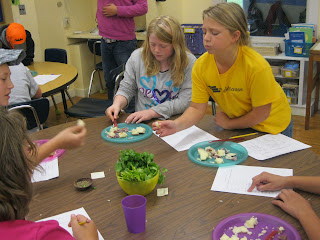Friday afternoon's mess does not justifies the $3 I saved in materials, but even still, our ice cream making adventure was a success.
The focus this week was on reading a recipe and measuring ingredients. I found a recipe titled Ice Cream for One that necessitated measuring liquid and dry ingredients using both measuring cups and measuring spoons. Best of all was the freezing method: place the ice cream ingredients in a small freezer ziploc (tightly sealed), then place that ziploc in a larger ziploc filled with salt and ice. Seal the big bag completely and then shake until frozen. Can you imagine a better activity for a Friday afternoon -- shake the bejeezus out of a bag and behold! Ice cream!
[You may be thinking, as I did, that this is an excellent recipe for food chemistry. We could spend more than one lesson on this between the phase changes and the salt depressing the freezing point of the ice. I've made note of this for next year when I am back in the first year cycle of science curriculum.]
In an attempt to be economical, I spent the week making ice cubes at home so I wouldn't have to shell out for bags of ice. (Also, the cubes melt slower so they seemed better than crushed ice for this job.) Each ziploc needed 1/2 cup of salt which totals a whole lotta salt. Luckily, Emilyinthekitchen had containers of iodized salt she doesn't cook with, so one less item to buy. When I mentioned my worry that someone wouldn't follow the recipe correctly and might mix the salt into the ice cream ingredients, she said, "Oh, I think some of them
need to eat salty ice cream." Prophetic words...
She also offered me large ziplocs, but they weren't of the freezer variety. I had already tested out the recipe with my own children using the recommended freezer ziplocs. Thursday night I took one of the non-freezer bags home and tried the recipe again. The results were the same, so I crossed freezer ziplocs off my shopping list.
Sometimes you think you're saving money, but it's really not worth it.
But let's talk about what did work, shall we?
Friday at 2PM I did a short introduction on how to measure liquid and dry ingredients. I also talked about the importance of reading a recipe carefully and making sure one understands each step. "Ask your partner, ask another student, ask me if you aren't sure," I told everyone. Then I handed out the recipes, set out the ingredients, and stood by with the camera.
As predicted, the bag shaking was a big hit.
What I didn't foresee were the variables between Liz-making-ice-cream-at-home and students-making-ice-cream-in-the-classroom. For one, it was about 60 degrees when I tested the non-freezer ziplocs. Compare this to a billion degrees in a stuffy Friday afternoon classroom. My shaking method is also a bit less...enthusiastic than the average eleven year old. The results being that everyone's ziplocs were leaking like fountains all over the tables and floors, and one duo gave such an almighty shake that the bottom of the bag split open in one fell swoop and two cups of melted ice mixed with half a cup of salt hit the floor with a ginormous SPLOOSH.
No picture of that - sorry.
After school when I told the teacher next door about the ziplocs, she shook her head and let out an, "Ohhh...." that made me realize what an idiotic thing I'd done. On the other hand, it was an opportunity for me to admit a mistake to my class (which I did) and accept responsibility for a foolish choice, something kids often have a hard time doing. But there it is. We all make mistakes, and hopefully we all learn from them.
Most kids got to enjoy ice cream like this:
But at least one pair had to beg a taste from friends as they dumped their salt into the ice cream ingredients. I didn't sweat it -- this was a logical consequence for their mistake. And one of the two even said, "Where's a copy of the recipe for me to try at home? I need to read it more carefully."
Bingo.
Clean up went
really well considering the watery messes scattered across the room. Everyone washed their own cups and spoons and most even remembered to dry them. As we raced to finish cleaning up the room at five minutes to three, a group of kids clustered around the sink and counter making sure everything got taken care of, and another hung out in the corner fooling around. I bemoaned this to Su, who reminded me, "It's still only September." We have many more months to streamline the process and make sure everyone's owning the process.
They left, having tracked salty wet footprints out of that one puddle and across the entire floor. I apologized profusely to the after school janitor and wished that we could just send in a couple of deer who would undoubtedly have the salt lick cleared off my floor in no time.



























